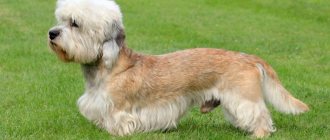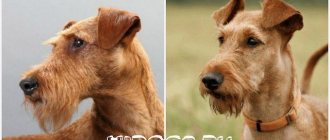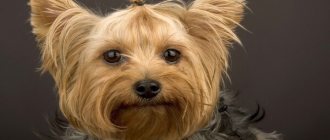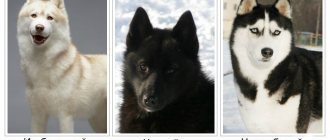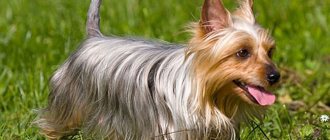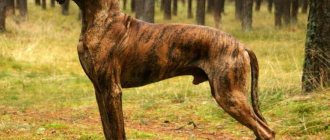Biewer Yorkshire Terriers are a young breed that appeared at the end of the 20th century.
During their existence, these decorative dogs, thanks to their pretty appearance, friendly character and unusual color, managed to conquer many dog breeders around the world.
In addition, the Biewer's coat does not shed and does not cause allergies.
They are active and have no trouble getting along with other pets and small children, making them ideal pets for people with active lifestyles and young families.
Origin story
Biewer Yorkies originated in Germany from breeders named Biewer. In 1984, in a litter of ordinary Yorkies, as a result of a mutation in the gene responsible for the presence of white spots, a puppy with black-white-gold fur was born.
The Biewer couple began breeding such unusual puppies and after 4 years of selection, in 1988, at a show in Wiesbaden, they presented to the public a new breed - the Biewer Yorkshire Terrier.
As an independent breed under the name “Biewer Yorkshire Terrier a la Pom Pom”, Biewers were registered by the German Dog Fanciers Club.
The latest version of the standard was signed in 2007; the breed was officially recognized in Russia in 2008.
Biewers are not just one of the color varieties of Yorkshire terriers.
American scientists conducted a genetic examination, the results of which revealed differences in the DNA of Yorkies and Mini Biewers, which indicates the use of blood from other breeds for their breeding.
History of the breed
The homeland of the Biewer Yorkshire Terrier is Germany. This breed cannot be called ancient, since the first Biewers were born only in the mid-eighties. The parents of the unusually colored offspring were Yorkshire terriers owned by German breeders Gertrude and Werner Biever. Having noticed puppies with white spots in the litter of their titled purebred Yorkies, the owners were not upset. Quite the contrary, they decided to develop a new breed of decorative dogs, fixing the tricolor color.
Breeding work was carried out by selecting Yorkshire terrier puppies that stood out for certain external qualities. The work was crowned with success. In 1988, the Beaver couple showed black and white Yorkies at an exhibition, the first purebred representatives of the new breed.
There was plenty of discussion around the new type of terrier. Regarding the appearance of these genes in Yorkies, there are two versions: 1. In a litter with black and white puppies, a recessive trait manifested itself. 2. Not the entire pedigree of the parents of the first black-and-white Yorkies was studied. Somewhere in the depths of the stud books, ancestors with white markings were “lost”.
Hypotheses have been put forward about the crossing of Yorkshire terriers in the process of creating Biewers with other breeds. According to assumptions, these are Shih Tzu and Maltese. But the guesses remained just that, guesses. The addition of genes from other breeds to the Biver Yorkshire Terrier breed has not been documented. The final standard was established and signed in 2007. Today, Biewer Yorkies are still listed as quite rare breeds.
Description of dogs
Biewers are small decorative dogs with a luxurious long coat.
Despite their small size, these are quite strong animals . They have a compact body, a flat back, a voluminous chest and a muscular croup that smoothly turns into a high-set tail.
Movements are free and graceful.
The coat is straight, does not hide the proportions of the body, but is thick and dense, silky, shiny, and as long as possible..
On the head, a combination of white-golden-blue or black-white-golden, with a symmetrical arrangement of white and colored spots, is acceptable.
Only 2 colors can be combined on the body: white and black or blue and white, without inclusions of a golden hue.
Breed characteristics
| Short description | |
| Origin: | Germany |
| Conditions of detention: | House, apartment (room only) |
| Purpose: | Companion dog, decorative dog |
| Color: | Mixed symmetrical coloring, including brown, silver, black, blue, gold and white (on the chest and head) |
| Wool length: | Long |
| Adult dog size: | Height at withers – 22-23 cm, weight – 2-3 kg |
| Average life expectancy: | 15-17 years old |
| Walk: | Walking twice a day is recommended |
| Physical activity needs: | Average physical activity needs (walks for 20-30 minutes, regular games) |
| Fédération Cynologique Internationale (FIC) classification: | The breed is not recognized by the FCI, but the German club places it in group 3: terriers, section 4: toy terriers |
| Puppy price: | 30,000-60,000 rubles. Without pedigree - up to 30,000 rubles, pet class - 30,000-35,000 rubles, breed class - 40,000 rubles, show class - 60,000 rubles |
Pet character
Biewers are ideal companion dogs.
They are devoted and equally attached to all family members, strive to always be close, accompany their owners everywhere and participate in all aspects of their lives. They need attention and care, they do not tolerate loneliness well.
These are active, affectionate, cheerful, inquisitive dogs with a balanced character and a stable psyche . It is important to remember that these are still terriers, which means they can be temperamental and stubborn.
NOTE!
Biewer Yorkies get along well with children and enjoy playing with them, get along well with other pets, and do not show aggression towards strangers.
However, if necessary, they will fearlessly defend their owner, despite their compact size.
Some representatives of the breed can be pugnacious and overly guard their territory, but this is the exception rather than the rule..
Character of Biewer York - description of the breed
Biewers are ideal companion dogs. They are ready to be close to family members around the clock and take part in all family matters with pleasure. Dogs quickly become attached to all members of the household and are happy to receive love and give it in return. The breed is incredibly loyal. The dogs get bored without their person, look forward to their owner’s return from work, and are joyfully greeted at the doorstep.
Cheerful, affectionate and very inquisitive animals that look like a beautiful fluffy toy are excellent antidepressants. It's impossible to get bored with them. Three-colored dogs have a stable psyche. One of the positive traits that these animals have is balance. However, do not forget that these are still terriers, so they may have bouts of stubbornness and outbursts of temperament.
From terriers, these animals inherited the brave heart of a lion and fearlessness. They don't know that they look like plush toys, so they boldly rush to protect their family members, protecting them from strangers who seem suspicious to them. But at the same time, dogs are not aggressive. Aggression is a disqualifying fault for this breed.
What character traits make beavers family favorites:
- Devotion.
- Positive attitude.
- Lovingness.
- Cheerful temperament.
- Curiosity.
- Activity.
- Loyal attitude towards children and other pets.
- High level of intelligence.
Important: do not leave your pets alone for a long time; they need constant attention and communication. Longing for people makes them nervous and moody.
How to identify a Biewer Yorkshire Terrier?
At the age of 2 months, the weight of a Biewer is approximately 900-950 grams. The entire body is evenly covered with hair, there are no bald spots or bald spots.
The coat is without undercoat, and subsequently flows down.
The color should not just be three-color, it should have a logic and a certain pattern: the chest, belly, front and hind legs are white, from the chest the white color rises to the neck and chin.
Ears should be erect or in the erect stage; drooping ears are unacceptable.
Caring for a Biewer Yorkie
Caring for a Biewer Yorkie
– it’s not an easy matter. And it doesn’t matter who you have: a show star or just a pet. Any Biewer needs careful care.
In the photo: caring for a Biewer Yorkie
To care for your Biewer Yorkie you will need:
- massage brush with metal teeth (the coating must be antistatic, the tips of the teeth must not have balls)
- massage brush (natural bristles)
- comb with rotating teeth
- plastic comb, metal tip
- fine tooth comb
- elastic bands for bangs
- nail clipper
- tangle cutter
Particularly difficult is caring for a long, beautiful coat.
The Biewer Yorkie's coat is completely straight, flowing down from the parting on the back. Sun rays, salty sea water, dry air - all this negatively affects its condition. The Biewer's coat needs to be brushed every day. However, it is easy to comb and hardly tangles.
Biewer Yorkies are bathed several times a month (if necessary - once every 7 days). For this purpose, special shampoos and conditioners are used to help keep the coat beautiful and healthy. But it is better to avoid “2 in 1” products. It is advisable to entrust the choice of shampoo and conditioner to a professional hairdresser. Keep in mind that the predominance of white in the color makes the wool quite distinctive.
You can easily learn how to wash and trim your Biewer yourself.
After washing the Biewer Yorkie, wrap it in a terry towel (for 5 - 10 minutes), then dry the wool with a hairdryer. First, a powerful stream of hot air is used, and the wool is sorted by hand. Then turn off the hair dryer and brush the dog. After this, the beaver is dried (a combination of warm air and cold currents). The last stage of drying is an exclusively cold flow.
From 5 months you can make oil masks (about 1 hour before bathing). They use different types of oils or a mixture of them (jojoba, flaxseed, coconut, almond, burdock, etc.)
Oil or balm can also be applied after combing. In this case, it is not washed off. But don't overdo it! It is unlikely that you will need more than 0.5 teaspoon. If you overdo it, the coat will look matted and greasy and will quickly collect dirt and dust. The oil is evenly applied with a soft brush to combed strands (not to the skin!) under the eyes, on the forehead, on the back of the nose, on the sides of the head and muzzle, on the neck and body, and finally on the paws.
It is important to remember that the rate of hair growth can vary depending on the period of a dog's life. For example, during the growth of teeth in a baby, as well as during estrus or pregnancy in a bitch, hair growth slows down. In addition, stress or illness can slow it down.
Proper, balanced feeding is very important for the condition of the coat and skin.
Caring for a Biewer Yorkie involves hygiene procedures.
Ears require regular examination. You will have to clean the ears with a special lotion (sold in veterinary pharmacies and pet stores) and cotton swabs. First, a few drops of lotion are placed in the ear and the ears are massaged for a couple of minutes. Afterwards, the cotton swab is also moistened with lotion, and the ears are carefully treated.
If there is no dirt in your ears, there is no need to clean them.
Excess hair on the tips of the ears is trimmed, so the ears look neat and small.
The fur between the toes requires special care. It is trimmed regularly.
Inspect the claws. If the beaver walks a lot on a hard surface, they can wear down on their own. If not, they need to be trimmed (at least once a month).
Dental care is also necessary. If your puppy is 8 months old and not all of its baby teeth have been replaced, contact your veterinarian. It may be necessary to remove baby teeth. Regularly treat your Biewer with special bones that clean the teeth and mouth. Bones can be found at a pet store.
Don't forget about preventive vaccinations. But before you vaccinate, give your dog an anthelmintic.
After the first vaccinations, a quarantine is maintained, during which you must refrain from walking. During this period, you can use a diaper or a dog litter box as a toilet.
Choose a harness that fits your Biewer Yorkie and treat your pet for ticks and fleas.
In winter, the Biewer Yorkie must be worn.
Breed standard
In accordance with the standard, the height of Biewer Yorkshire Terriers should be 21-22 cm, weight – 2-3.1 kg.
Bitches can be 5 cm higher and 500 grams higher. heavier if the proportions and graceful appearance are maintained.
Breed standard:
- The head is small, proportional to the body. The forehead is wide and flat.
- The teeth are small, even, white. Full teeth and a scissor bite are preferred, but a maximum of 2 premolars and a pincer bite are acceptable.
- The nose is quite wide, slightly protruding, and pigmented black.
- The eyes are round, slightly convex, and small. Widely located. The iris is dark brown. The eyelids are dense, with a black edging.
- The ears are set high, small, triangular, erect and adorned with fur.
- The body is rectangular, the back line is straight. The chest is narrow but deep.
- The limbs are straight, the joints are well developed and harmoniously located. The shoulder blades are slightly inclined. The croup is strong and muscular. The claws are narrow, short, matching the coat, most often black or natural white.
- The tail is set high and covered with decorative hair. When lowered, it reaches the hock joints.
Any deviations from the standard are considered a fault in the breed.
Origin of the breed
Thirty years ago, in the German city of Hunsrück, Biewer breeders engaged in breeding Yorkies discovered unusual puppies in one of their litters. The babies differed from standard Yorkshire terriers in their brighter colors.
The couple decided to work on strengthening and developing the new breed. A few years later, in 1988, they introduced tiny charming dogs with elegant fur to the canine community. The breed was named Biewer Yorkshire Terrier.
Due to the huge demand for decorative breeds, small Biewers immediately gained popularity throughout the world. In 2007, a breed standard was adopted, but adjustments are still being made to it, since Biewers are still in their infancy. Two years later, the breed, as one of the varieties of Yorkies, was registered by the Cynological Federation of the Russian Federation.
Difference from a regular Yorkie
The main difference is the color. The fur of Yorkshire terriers is dark, steel-blue in color, while Biewers have a light coat and white markings on the head.
There are also differences in:
- physique - beavers are larger, more muscular, their limbs are stronger;
- time and place of appearance - Yorkies appeared in the 19th century. in Great Britain, and beavers at the end of the 20th century. in Germany;
- quality of wool - Biewers have thicker, denser and more stain-resistant wool, which is less likely to get tangled.
Experts say that the immunity of Bievers is stronger than that of ordinary Yorkies..
The unusual color and long shiny coat make Bievers stand out among other decorative breeds and serve as the main distinguishing mark from Yorkshire terriers.
In addition, beavers are stronger and faster due to their strong limbs and strong bones.
They also have better health - they are much less likely to have problems with their limbs.
Read a description of standard Yorkies here.
Advantages and disadvantages
The main advantages of Biewer Yorkshire Terriers:
- bright and unusual appearance;
- compact size, allowing the pet to feel comfortable in a small apartment;
- stable psyche;
- non-aggressive character;
- lack of shedding and specific odor;
- intelligence and intelligence.
The disadvantages of the breed are related to the exterior: asymmetrical color, light eyes, drooping ears, short and curly hair.
Character
The Biewer Yorkshire Terrier has several characteristic features:
- good-natured;
- playful;
- smart;
- curious;
- active;
- the dog has a stable psyche;
- gets along with owners;
- protects the family from strangers and other dogs;
- communicative;
- perfectly trainable.
On a note! It is important not to spoil your pet, otherwise the dog will be uncontrollable and capricious. You need to buy a puppy between 2 and 4 months of age. An adult dog becomes strongly attached to its owner; moving to a new place of residence or to other people results in severe stress and illness. The Biewer Yorkshire Terrier does not like a change of environment, especially as an adult pet.
Life expectancy and health
Biewers are the longest-living dogs among other decorative breeds.
Their average life expectancy with proper care is 13-15 years or more.
At the same time, they have a tendency to the following diseases:
- congenital vascular disease – manifests itself in puppyhood and leads to stunting of the pet’s growth;
- pancreatitis - occurs as a result of poor diet;
- Legg-Perthes disease – necrosis of the femoral head.
Biewers often inherit genetic pathologies such as:
- violation of teeth change;
- districhiasis;
- tracheal collapse;
- dislocation of the kneecap;
- cryptorchidism;
- allergy;
- sensitive digestion.
IMPORTANT!
To keep your pet healthy, regular preventive examinations and immediate treatment are necessary if dangerous symptoms are detected.
It is also important to promptly deworm your pet and treat it against fleas and ticks.
Content Features
Beavers are ideal for living in city apartments. These are clean dogs, caring for which is not burdensome.
Despite the fact that they can be trained to a tray or a diaper, Biewers need regular walks and physical activity to promote the proper development of the dog’s psyche, physical health and socialization.
The pet must be brushed daily and bathed no more than once a week using hypoallergenic shampoo..
The hair on the head should be collected in a ponytail to prevent hairs from getting into the eyes and irritating them.
Once a month, starting from 4 months of age, the Biewer needs to be cut.
If the dog participates in exhibitions, the haircut should be standard.
Hygienic care is also necessary, which consists of trimming the muzzle and ears.
To avoid skin irritation and eczema, you should wipe your Biewer's eyes daily with a damp cotton pad..
The dog's teeth should be brushed once a week at home and 2 times a year at the veterinary clinic.
You should also clean your pet's ears weekly and trim his nails monthly.
It is necessary to accustom your pet to hygiene procedures from a very early age..
Features of keeping the Biewer York breed
A small decorative dog is not suitable for outdoor living. This is a pet. Maintaining the apartment will not require much effort from the owners. These animals don’t need a lot of space. They can be taught to use a tray and a diaper - this will become a lifesaver for busy owners. Biewers do not shed, so there will be no problems with cleaning. Not a dog, but a real gift.
However, it is worth remembering that all terriers are incredibly active, they need a lot of daily exercise, and long walks are an essential part of these dogs' daily routine. If the beaver does not get rid of the accumulated energy outside the home walls, then it can redirect it to destructive activities in the apartment. Insufficient walking can result in chewed things.
Feeding Bievers
You can feed Biewer Yorkies with natural products or ready-made dry food, but you need to choose one thing - you cannot mix 2 types of feeding.
With a natural diet, the basis of the menu should be lean meat, as well as lean sea fish, tripe, boiled offal and buckwheat or rice porridge.
In addition, the menu should include:
- dairy and fermented milk products;
- vegetables;
- fruits;
- greenery.
Can't give:
- bones, especially tubular bones;
- river fish;
- fat meat;
- sweets, smoked foods, pickles and marinades;
- bakery products;
- legumes
To prevent plaque and when changing teeth, beavers should be given compressed beef tendons.
It is necessary to give your pet an additional vitamin and mineral complex.
The serving is calculated based on the weight of the animal: one tablespoon of food for every 500 grams of weight.
Feeding dry food saves time on food preparation, does not require additional vitamins, and the recommended portions are indicated on the package.
Economy class feed should be avoided due to the likelihood of containing flavor enhancers, dyes, antibiotics and flavorings. Suitable food for Bievers should be premium or super premium.
The following brands have proven themselves well:
- ROYAL CANIN (Yorkshire Terrier Junior, Yorkshire Terrier Adult);
- Orijen;
- Purina Pro Plan;
- Mera Dog;
- Hill's;
- Acana.
An allergic reaction and gastrointestinal upset may occur due to improperly selected food.
Care and maintenance
The Biewer Terrier requires attention, like other dog breeds, but the owner should know some of the maintenance features in advance. The dog must be taught the rules of behavior in the home and on the street: an ill-mannered, spoiled pet is a disaster for the owners and others.
Grooming
Hair care is much easier than the coat of a Maltese dog. In the absence of exhibition work, a hygienic haircut (short hair) is useful; be sure to inspect the pad area and remove matted hair. Be sure to comb your pet every day to prevent tangles from appearing.
Unlike many breeds, the Biewer Yorkie practically does not shed, and hair renewal occurs at a slow pace. The apartment will not be covered with clumps of fur, as with seasonal shedding in many dogs.
Vaccinations
The first vaccination is given to Biewer Yorkies at 8–9 weeks. We need a comprehensive vaccine to protect against dangerous diseases:
- plague,
- leptospirosis,
- parainfluenza,
- hepatitis A,
- parvovirus.
Abbreviations: DHPPi and Lepto. At 12–13 weeks, a second vaccination is carried out, and an anti-rabies component must be added. Every year the dog should receive vaccinations according to the recommendations of the veterinarian according to the standard schedule.
Important! Before vaccinating puppies and adult dogs, it is imperative to combat worms.
Bathing
You need to keep your coat and skin clean with regular water treatments, about once a month. Dogs love to bathe, especially with toys. It is important to use special hair care products for dogs; regular shampoo is not suitable.
The wet wool is dried using a hairdryer. It is important to ensure that dandruff does not appear from hot air currents. After the procedure, be sure to comb your pet.
Puppies nutrition
The number of feedings depends on age: it is important to provide high quality food, the same as that provided by breeders. The transition to a new type of nutrition is carried out gradually.
Useful names:
- boiled buckwheat,
- rice,
- turkey,
- vegetables,
- once a week - boiled fish without bones.
It is important to give:
- olive oil,
- cottage cheese,
- hard boiled eggs,
- processed ground meat, necessarily boiled.
Do not mix natural food and dry food. After six months, puppies are fed three times a day.
Nutrition for adult dogs
The main part of the diet is maintained, but as the pet grows older, it should receive more food. An important difference from the diet of puppies is that milk is replaced by dairy products. An adult Biewer Yorkie gets food twice a day. As a treat, it is advisable to give a meat bone, which must be soft. It is important that the products are fresh.
Dry food or natural food? This issue is decided by the owner individually, depending on how busy he is at work and the availability of free time to prepare food for the dog. Dry food is a good and convenient option for feeding a Biewer Yorkie when the owner is busy. It is important to choose super premium class or diet food. Premium food is acceptable as a temporary measure.
You should not give your dog:
- chocolate,
- sweets,
- smoked meats,
- soups and borscht,
- vegetables that cause bloating
- fried food,
- salads with mayonnaise.
Walks
The Biewer Yorkshire Terrier is less active than the fidgety Yorkie, but the pet needs regular trips outside and outdoor games. While on the street, the pet must be on a leash so that the dog does not get lost and does not enter into conflicts with other animals, especially those larger than itself.
If it is impossible to walk, the pet can calmly relieve itself in the litter tray, but you should not constantly deprive your Biewer Yorkie of the opportunity to frolic in the air. The animal loves toys: soft bones, balls, needle-shaped rubber hedgehogs, rings, and enjoys playing with its owner on the playground.
Training
The first stage is to accustom the dog to order. The Biewer Yorkie remembers well that he needs to go to the litter box. Next, the owner must teach the pet basic commands so that he can safely appear with the animal in public places. The dog must know and follow the commands “sit”, “lie down”, “back”, “to me”, “stay”, “fu”.
After the first stage, you need to teach your pet to follow more complex rules: do not receive food from strangers, do not steal food from the table. An important point is the acceptable position of the leash for walks: ill-mannered dogs often pull on the strap, which prevents the owner from calmly walking with the pet and harms the animal: the harness cuts into the body. The owner of the vehicle will have to accustom the pet to sitting on the seat while driving. Many owners add elements of the game: the dog, upon request, gives a paw or performs the “voice” command. Encouragement with words and treats, the correct tone, absence of screaming and nervousness are mandatory elements during training.
Caring for your teeth and ears
Be sure to clean the ear canal with a cotton swab. You need to act carefully so as not to harm your pet. The hairs at the tips of the ears are trimmed.
It is important to ensure that food does not remain on your teeth after eating. It is useful to buy a special toothbrush for dogs and use it regularly after consulting a veterinarian.
Nail trimming
The procedure is carried out using nail scissors. Nail trimming is done less frequently in the summer: with frequent walks, the dog wears off the stratum corneum on the ground. It is important to cut off a minimum amount of length so as not to disrupt the integrity of the blood vessels.
Learn about the first signs and symptoms of piroplasmosis in dogs, as well as how to treat the disease at home.
The characteristics of the pug breed and the features of keeping a small dog can be seen in this article.
Go to the address and read about what ear mites look like on dogs and how to get rid of the parasite without harming your pet.
Health
With good care, the Biewer York does not cause any trouble for its owners, but there are hereditary pathologies that you need to be aware of. Some small dogs, such as the Maltese, have “running” eyes; this problem is rare in the tri-colored terrier.
Breed diseases:
- shunts that provoke convulsions, vomiting, and digestive disorders;
- pathologies causing muscle atrophy and lameness;
- pancreatitis, which negatively affects the general condition.
Training and education
Biewers are not working dogs, not hunting or guard dogs, so they do not need any special knowledge; it is enough to instill in them the rules of behavior and teach them order.
These dogs are quite easy to train to a litter box or diaper, so this is where you should start.
Afterwards, you need to teach your pet simple commands, such as “fu” “come”, “lie down”, “sit” and “place”, which promote adequate behavior of the animal during walks and help avoid such unpleasant situations as eating garbage or damaging things.
It is also necessary to teach the Biewer to refuse food offered by strangers.
Representatives of this breed are smart and quite easy to train, but they can become stubborn and shirk their activities, so the owner must show persistence and patience (the training process is shown in the photo).
You can’t physically punish a dog - for a Biewer, just raise your voice a little and change the intonation and they will understand everything, as they are sensitive to changes in the owner’s mood.
Rewards in the form of treats or praise for correctly executed commands are welcomed.
Price range
The price of Biewer Yorkshire Terrier puppies depends on the location of the kennel, the class of the puppy, and the titles of the parents.
In nurseries, puppies suitable for participation in exhibitions and breeding cost an average of 50 thousand rubles or more, pet class dogs - 15-35 thousand rubles.
You can purchase a puppy without a pedigree through an ad, second hand. The cost will be much lower, but the pet will not be completely healthy.
Description
The Biewer Yorkshire Terrier has characteristic features of color and appearance; it is difficult to confuse the breed with similar varieties. A companion dog is suitable for living in an apartment and participating in exhibitions. In recent years, charming small pets are often taken with them to various events and glamorous parties.
Appearance
The Biewer Yorkie retains its cute puppy-like characteristics throughout its life. The tri-color color is a characteristic feature of the dog, which looks like a plush toy.
Breed standard:
- coat color. Three colors are required: white, golden, black or white with gold and gray. White color must be present in any case;
- weight. The average is about 3 kg, bitches can weigh a little more - up to 3.5 kg;
- coat: silky, shiny, long, parted on the back. It is advisable to cut the Biewer Terrier's hair so that the hairs do not touch the floor: this makes it easier to care for the coat. When participating in exhibitions, you will have to maintain a certain length of the cover and trim it according to standards;
- the height at the withers permissible for a purebred pet is no more than 27 cm, average sizes are up to 22 cm;
- life expectancy. The indicators are within 17 years;
- The length of the pet is slightly higher than the height at the withers. The dog is strongly built, the paws are short. The head has a flat skull, the neck is quite long. Dark eyes look like beads.
How to choose a puppy?
This is a rather rare breed that is gaining popularity, therefore, in order to purchase a healthy and purebred Biewer, you should contact specialized nurseries, and not buy a dog from your own hands..
Before purchasing, you need to find out from the breeders about the character and origin of the puppy, the health and titles of the parents, inspect the premises where the dogs are kept, find out about their living conditions and nutrition.
To exclude the possibility of purchasing a puppy with the wrong color, unpigmented nose and eyelids, and light irises, you must carefully examine it and compare it with the breed standard.
In a healthy puppy:
- cheerful look;
- there is no fear of people;
- rather thick paws and short hair;
- proportional torso;
- not bloated belly;
- dark eyes, no discharge.
CAREFULLY!
You can take a puppy to a new home only after he is 2, or preferably 3 months old.
Pedigree traits will appear when the puppy reaches 5-6 months.

